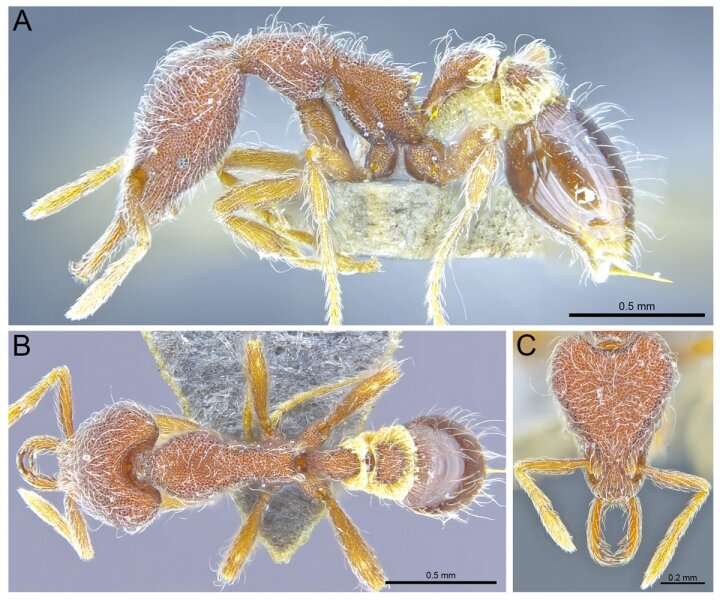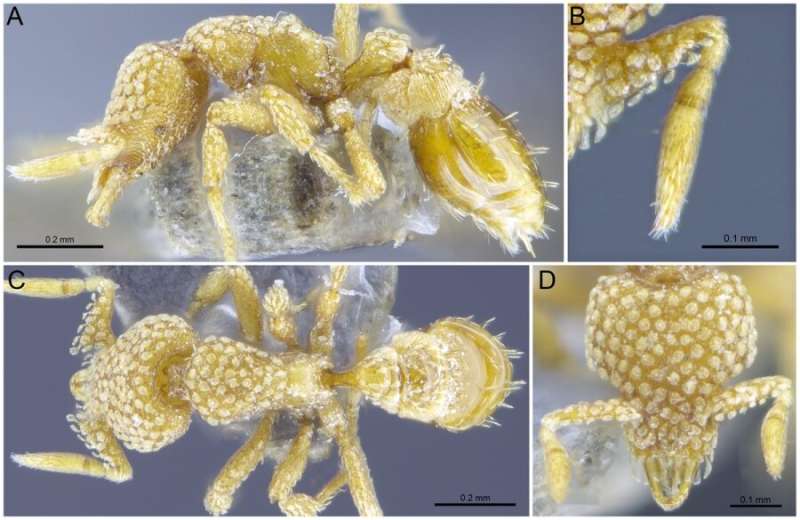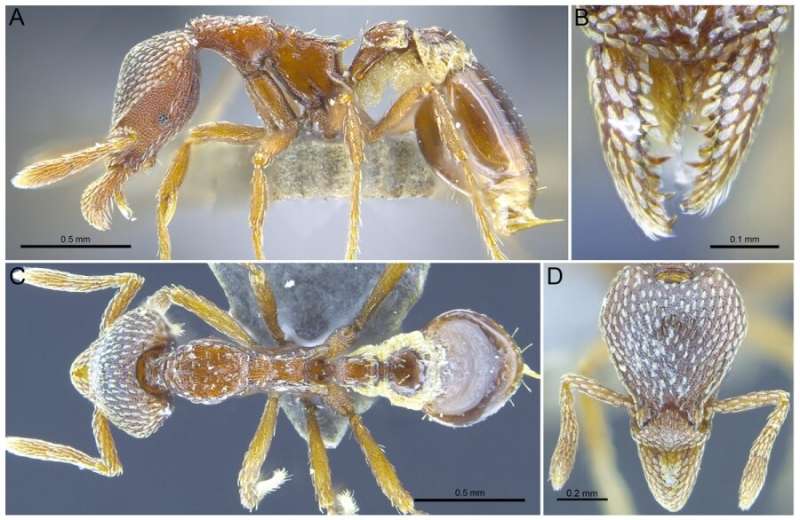Thirteen new ant species discovered in Hong Kong

In two separate articles recently published in Zookeys and Asian Myrmecology, Dr. Benoit Guénard from the School of Biological Sciences of the University of Hong Kong (HKU) and his team has expanded the knowledge on Hong Kong ants by adding 13 species to the 174 species officially recorded.
Among those are three new species of the genus Strumigenys, also known as miniature trap-jaw ants, new to science and thus far, found only in Hong Kong. As their name indicates, these species are tiny, measuring only 2 to 4 mm long, but are astounding predators of the small arthropods living in the forest leaf litter. They can open their mandibles widely and snap their prey with the fast-closing movement of their mandibles.
The new species described by a recent HKU graduate student Wilfred Kit Lam Tang, and the researchers Mr. Mac Pierce and Dr. Benoit Guénard are named Strumigenys hirsuta, in reference to their hairy appearance; Strumigenys lantaui, as this extremely rare species is found only within a single locality on Lantau Island; and Strumigenys nathistorisoc, in honour of the Hong Kong Natural History Society, which funded this research.

Another five species of Strumigenys are newly recorded from Hong Kong, but had already been described from other Asian regions. One of them, Strumigenys formosa, was found only in Taiwan, where two queens have been collected since its discovery in 1988. For the first time, the worker caste is thus described from a single specimen collected in Tai Po Kau Nature Reserve; enhancing the knowledge on this species' distribution and its importance for conservation. Other species recorded were previously found in Southeast Asia, Japan, Taiwan or other provinces of China. Finding these new, rare species is a good thing for Hong Kong and its biodiversity, but other discoveries are more worrisome.
Indeed, five of the species newly recorded are non-native to Hong Kong, four belonging to the Strumigenys genus, and one, Brachymyrmex patagonicus, recorded for the first time, from mainland Asia. This latter is an urban pest well known for its ability to enter and establish nests within a wide range of buildings, like hospitals, hotels, schools and houses, and to colonise various rooms such as kitchens, offices and laundry rooms, but also more sensitive areas such as infirmary and neonatal units. In some American states, where it is an invasive species, it now causes the most frequent intervention from pest control companies. If the population in Hong Kong, currently found only in Hung Hom, was to proliferate, it would most likely induce an increase in pest management costs and more frequent use of pesticides.

The discovery of five more exotic species in Hong Kong, like the fire ants (Solenopsis invicta) in the early 2000s, highlights the regional importance of Hong Kong in importing species, some with important consequences for human populations and local biodiversity. It also indicates the need to deploy efficient survey and monitoring programmes to quickly detect these species after their arrival so targeted actions to suppress them or limit their spread through Hong Kong and beyond can be activated.
Monitoring Hong Kong insects can thus reveal both beautiful and alarming discoveries. With probably several hundreds if not thousands of species waiting to be found, it shows the fantastic diversity that the city still has to offer if protected sufficiently. In parallel, it also represents an important step for uncovering more alarming species, in particular exotic ones for which early detection represents a key requirement to ensure success in the limitation of their spread and negative impacts.
More information: Kit Lam Tang et al. Review of the genus Strumigenys (Hymenoptera, Formicidae, Myrmicinae) in Hong Kong with the description of three new species and the addition of five native and four introduced species records, ZooKeys (2019). DOI: 10.3897/zookeys.831.31515
Benoit Guénard. First record of the emerging global pest Brachymyrmex patagonicus Mayr 1868 (Hymenoptera: Formicidae) from continental Asia. Asian Myrmecology, 2019 DOI: 10.20362/am.010012
Journal information: ZooKeys
Provided by The University of Hong Kong

















